View or download the July/August 2019 issue as a color PDF here, or read single articles below. Articles in this issue: From Here to There: Belmont’s Roadmap to Decarbonization By Roger Colton The Belmont Energy Committee’s 2018 “Roadmap for Strategic Decarbonization” will allow periodic measurement of progress toward the objective of reducing emissions by 80 percent by 2050. Read more. Buying Local: Electricity from Belmont Light By Marty Bitner In Belmont, there are clear benefits to buying local when it comes to energy usage, and that means powering our lives with electricity whenever possible. Read more. Belmont Energy [READ MORE]
From Here to There: Belmont’s Roadmap to Decarbonization

By Roger Colton The adage is timeless: think globally, act locally. On climate change issues, Belmont has taken that advice to heart. In 2009, a Belmont Special Town Meeting approved the goal of 80 percent emissions reduction by the year 2050. The following year, the Belmont Energy Committee was organized and appointed to pursue that goal. In 2016, the committee examined the change in CO2 emissions between Belmont’s first greenhouse-gas inventory of 2007, and the most currently available data, 2014. They estimated that total emissions from electricity, transportation, and heating fuels declined by 5 percent in those seven years. Energy [READ MORE]
Buying Local: Electricity from Belmont Light
By Marty Bitner In Belmont, there are clear benefits to buying local when it comes to energy usage, and that means powering our lives with electricity whenever possible. In contrast to the investor-owned corporate utilities serving many of our neighboring communities, where financial benefits primarily flow to shareholders who live far away, Belmont Light is a municipal electric utility, operated in the public interest. In Belmont, we are both the customers and the shareholders, and doing what is best for ratepayers is always the objective. Our electric rates are determined not only by the amount of money needed to purchase [READ MORE]
Belmont Energy Reference List
REFERENCE LIST for July/August 2019 Belmont Energy Committee articles _______________________ Belmont Composts! belmontcomposts.org jwusauk@aol.com Belmont Drives Electric belmontdriveselectric.org belmontdriveselectric@gmail.com Belmont Energy Committee belmontclimateaction.org contact via web form Belmont Energy Roadmap belmontclimateaction.org/initiatives contact via web form Belmont Light belmontlight.com customerservice@belmontlight.com Belmont Light Green Choice belmontlight.com/energy-solutions/residential-programs/ HeatSmart heatsmartbelmont.org heatsmartbelmont@gmail.com
Belmont Light’s Role in Energy Efficiency
By Roger Colton Belmont’s commitment to a long-term goal of strategic electrification will not scale back Belmont Light’s energy-efficiency programs. In Belmont, strategic electrification involves increasing electricity use primarily by electrifying transportation and home heating/cooling. Belmont Light says there’s no conflict between this effort to increase electricity use and its offer of energy-efficiency programs. According to Ben Thivierge, energy specialist for Belmont Light, the phrase “energy efficiency” has “changed its meaning. Energy efficiency used to mean simply not using electricity.” Today, he said, “there’s a larger scope. ‘Energy efficiency’ today is associated with decarbonization. It is through energy efficiency that [READ MORE]
HeatSmart Belmont: Electrifying Home Heating and Cooling

By James Booth Heating buildings by burning fossil fuels such as oil and natural gas accounts for almost half of Belmont’s climate-warming CO2 emissions. A key strategy in Belmont’s Climate Action Roadmap is switching to carbon-free electricity as a pathway to zero emissions. So how can one efficiently heat a building using electricity? The answer is heat pumps. Heat pumps work by moving heat from one place to another, much like a refrigerator or air conditioner that can also operate in reverse, able to heat in winter and cool in summer. Traditional electrical baseboard heaters or other “resistance” systems convert [READ MORE]
New Belmont School Leads Way with Zero Net Energy
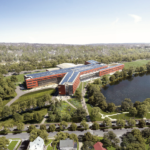
By Jacob Knowles The latest climate science indicates that we must reverse the historic trend of emissions escalation and begin actively extracting CO2 from the atmosphere. Energy consumption by buildings represents 28 percent of annual global greenhouse gas (GHG) emissions, which means that zero net energy (ZNE) buildings are a core component of achieving a livable climate. On the bright side, there has been exponential growth in ZNE buildings, with a 700 percent increase between 2012 and 2019 in completed and emerging ZNE buildings in the US and Canada, as documented by the New Buildings Institute. This growth is happening [READ MORE]
Roadmap Review: What’s In, What’s Out, and Why
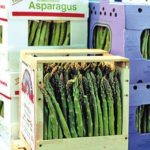
By James Booth Belmont’s Climate Action Roadmap focuses on promoting electrification of vehicles and heat-pump heating, coupled with carbon-free electricity. For an individual Belmont resident, is it enough to convert to clean electricity to help fight climate change? No. Here’s why: First, in addition to shifting our energy use to clean electricity, it will remain as important as ever to take every opportunity to use less energy through conservation and efficiency, as discussed elsewhere in this newsletter. This includes walking, biking, carpooling, and taking public transit when possible to move ourselves around. Weatherizing our houses to stay comfortable with less [READ MORE]
Electric Vehicles: One Owner’s Perspective

By Marty Bitner New cars today offer an array of features and options. The most important option, however, is how your car is fueled, and lately options for electric vehicles (EV) are getting better. Today, enough fully electric and plug-in hybrid models are available to meet the needs of most people. You owe it to yourself to consider making the switch from a gas-powered car to an EV. My family did over a year ago; we’ll never go back. EVs are fun to drive. When you step on the accelerator, the car responds instantly: it just goes. This [READ MORE]
Michael Smith Honored by Belmont Historical Society
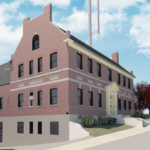
By Evanthia Malliris The Belmont Historical Society presented the 2019 David R. Johnson Preservation Award to Michael A. Smith, AIA, at its annual meeting this spring. Smith was nominated for his work on the rehabilitation and restoration of the Belmont Police Station Building as well as more than two decades on the Belmont Historic District Commission. “Mike brings a deep architecture knowledge, commitment to historic preservation, and a collaborative spirit to the Belmont Historic District Commission that has contributed significantly to many of the commission’s successes, including the adoption of two new historic districts, completion of a town-wide historic resource [READ MORE]
Letter to the Editor, July-Aug 2019
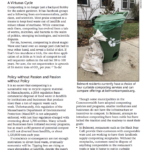
More on disposing in the kitchen sink As a resident of Newton for 20-plus years and an activist in Waltham as well (Waltham Land Trust), I salute Belmont on your newsletter. It stands out, in my experience, as the best suburban NGO volunteer-run information medium. I’ve used its articles in my teaching at Brandeis. So, bravo and well done. I have a question for Mary Bradley, the compost fanatic (I am one, too, and refer to the May/June 2019 article, “Composting in Belmont: Breaking it Down,” typical of BCF articles in its detail and usefulness), and it’s this: has she [READ MORE]
Belmont Porchfest Returns on Saturday, Sept. 7

Get ready to make some noise in your neighborhood! By Mary Bradley On Saturday, September 7, 2019, Belmont Porchfest, the community-wide music and arts festival, is returning for its second year. (Rain date Sunday, September 8.) Live music, interactive arts, and other events will begin at 10:30 AM and run until 6:30 PM at locations all over town, including additional flourishes at the grand finale specifically for vegans and cyclists. For Belmontians who might enjoy a moment of fame, seek out cameras positioned on street corners to capture your thoughts about the day for Makin’ Noise, a documentary film in [READ MORE]
Community Meets at the Market

By Evanthia Malliris Summertime means it’s time to gather at the Belmont Farmers’ Market. For 14 years, the market has been a welcoming spot that offers fresh, local food along with music, storytelling, and activities for kids. Visitors can see neighbors, try new offerings from guest vendors, and meet representatives from the town and local organizations at the Community Table. This year’s new vendors include: Beverly Bees C & M Farm Common Acre Farm Just Hummus Lilac Hedge Farm Mariposa Bakery, Tick Tock Chocolates When Life Gives You Lemons The Market matches SNAP benefits up to $20 per shopper each [READ MORE]
Belmont Roots, July/August 2019
Environmental News, Notes, and Events By Meg Muckenhoupt Reducing emissions can begin in your own backyard—but how? Well, if you’re tired of mowing your lawn, you have a good excuse to stop. Although grasses, like all plants, remove carbon from the air when they grow their leaves and roots, the greenhouse gas emissions from fertilizer and pesticide production, mowing, and leaf blowing make grass a poor proposition for our climate. You still have to do something with that land, but there are many other good choices that will look good and keep more carbon in the ground and out of [READ MORE]
May/June 2019 Belmont Citizens Forum Newsletter & PDF
View or download the May/June 2019 issue as a color PDF here, or read single articles below. Articles in this issue: New Plans for McLean Land Density is key issue as town considers proposals for two McLean campus parcels By Sue Bass Twenty years ago, Belmont voted to allow development on McLean Hospital land on Belmont Hill. Now McLean is coming back to the town with new proposals for two parcels of land that are still undeveloped. Read more. Composting in Belmont: Breaking it Down By Mary Bradley Composting is no longer just a backyard hobby for the ardent gardener. [READ MORE]
New Plans for McLean Land
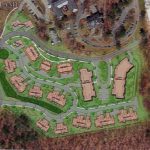
Density is key issue as town considers proposals for two McLean campus parcels By Sue Bass Twenty years ago, Belmont voted to allow development on McLean Hospital land on Belmont Hill. The town-wide referendum of July 1999 endorsed the previous Town Meeting vote to change zoning for 238 acres. The largest portion for new construction became the Woodlands, 121 luxury townhouses on twenty-six acres. Another portion became Waverley Woods, 40 units of affordable housing on an acre and a third. Some land was preserved from construction. One hundred and twenty acres were set aside for open space, and fourteen acres [READ MORE]
Composting in Belmont: Breaking it Down
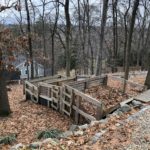
By Mary Bradley A Virtuous Cycle Composting is no longer just a backyard hobby for the ardent gardener. It has Facebook groups and a following from environmentalists, politicians, and scientists. Most praise compost as a means to keep food waste out of landfills and reduce release of methane. While consensus ends there, composting has evolved from a tale of worms, microbes, and bacteria to the realm of politics, emerging technologies, and scientific disputes. For me, however, composting is about magic: Wave one hand over an orange peel clutched in your other hand, and reveal a fistful of dirt. If that’s [READ MORE]
WEEDS: Plants in the wrong place

By Lucia Gates All photos courtesy of Wikimedia Commons Like gardeners everywhere, we Belmontians struggle with weeds. While it might be tempting to take the easy approach and eliminate them with herbicides and chemical weed killers, as gardeners we also know that we have to protect everything in our garden. There are ways to manage weeds safely. This article focuses on flower beds and not lawns, although some of the information will be useful in grassy situations. Also, some weeds, such as wild grape vines and wild multiflora roses, are unlikely to be a problem in a flower bed, but [READ MORE]
Painstaking Progress on Belmont’s Multi-Decade Environmental Emergency

By Anne-Marie Lambert Belmont is working under a federal consent order to reduce the pollution it sends into Boston Harbor from leaks and connections of underground sewer pipes into the storm drain system. Cleanup According to the town’s January 30 Compliance Report to the US Environmental Protection Agency (EPA), Belmont redirected an additional 126 gallons per day (GPD) of sewage from our brooks and ponds to the Deer Island treatment plant in Boston Harbor. Sources included leaking sewer service laterals and sewer segments on Brettwood Road and Pierce Road (84 GPD) and three leaking sewer service laterals along Hoitt Road [READ MORE]
Belmont Roots, May/June 2019
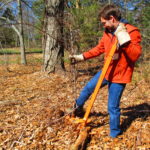
Environmental News, Notes, and Events By Meg Muckenhoupt Well, it’s spring, sort of. The average last frost date in Belmont is somewhere between May 1 and May 11, depending on which website you believe—the Old Farmer’s Almanac? Plantmaps.com? But my grandmother in Newton never planted her tomatoes before Memorial Day. Warmth-loving plants such as tomatoes and peppers are sensitive to soil temperature as well as air temperature. They can suffer “transplant shock” and become stunted and grim if roots are a bit too chilled. Seeds are more secure in their identity, and will simply sit and shiver in the soil [READ MORE]

